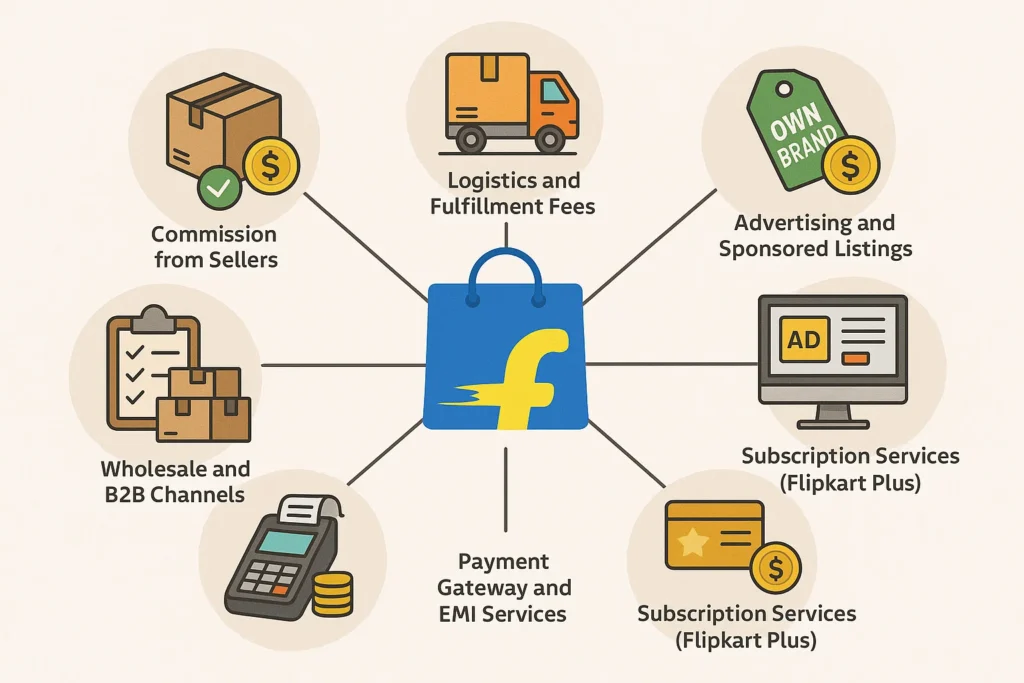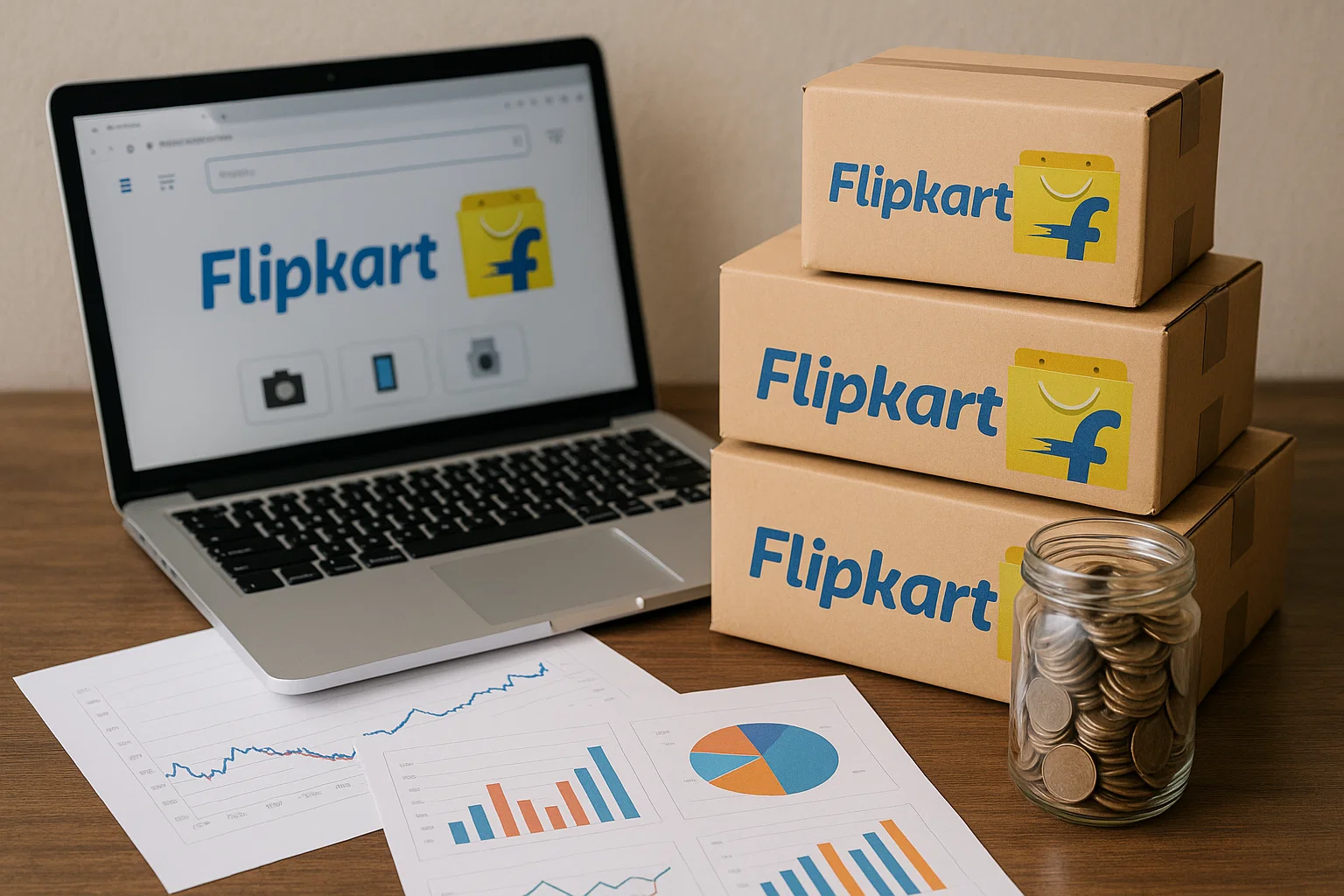Flipkart has grown from a humble online bookstore in 2007 to one of India’s largest e-commerce platforms, rivaling giants like Amazon and Reliance. With a presence across electronics, fashion, groceries, and home essentials — Flipkart has become a household name and a trusted digital marketplace for millions of Indian consumers.
Backed by Walmart and operating under the umbrella of Flipkart Group (which includes Myntra and Cleartrip), Flipkart dominates with a hybrid retail model combining direct sales, third-party seller listings, and massive festive-season campaigns. But what truly powers its growth? A diverse and scalable revenue model.
In this blog, we’ll explore how Flipkart earns money, break down its revenue streams, explain why the model works so well in 2025 — and how startups can replicate it using a Flipkart clone powered by Miracuves.
Build the next Flipkart with a leading e-commerce app development company trusted by startups and enterprises worldwide.
How Flipkart Makes Money
Flipkart operates a multi-layered revenue model that blends e-commerce retail, platform services, advertising, and logistics. Here are the primary income sources that fuel its business:
- Commission from Sellers – Flipkart charges sellers a percentage fee on every transaction, varying by category.
- Logistics and Fulfillment Fees – Sellers pay extra for warehousing, packaging, and delivery through Flipkart’s in-house logistics arm, Ekart.
- Product Margins on Private Labels – Flipkart sells its own brands (e.g., MarQ, SmartBuy) with higher profit margins.
- Advertising and Sponsored Listings – Brands and sellers pay for visibility through native ads, banners, and top-of-search placement.
- Subscription Services (Flipkart Plus) – Loyalty programs offering early access and free delivery generate indirect monetization through customer retention.
- Payment Gateway and EMI Services – Flipkart earns fees from payment facilitation and EMI conversion via its fintech partnerships.
- Wholesale and B2B Channels – Operates wholesale units that cater to kirana stores and retailers under a separate vertical.

These revenue streams allow Flipkart to generate income from both B2C transactions and B2B enablement — making its model robust, high-volume, and tech-driven.
Flipkart grew from a startup to a retail giant by blending e-commerce with fintech—explore the Flipkart business model to see how it operates in 2025.
Detailed Breakdown of Revenue Channels
Commission from Sellers
Flipkart operates as a marketplace where third-party sellers list their products. The platform takes a commission on each sale, typically ranging from 5% to 25% depending on the product category (e.g., electronics, fashion, home decor). This is one of Flipkart’s most consistent and scalable revenue streams.
- Who Pays? Independent sellers and small businesses
- Why It Scales? Low overhead; Flipkart earns from every transaction without holding inventory
Logistics and Fulfillment Fees
Through its logistics arm Ekart, Flipkart provides warehousing, packaging, and last-mile delivery services. Sellers using “Flipkart Fulfilled” pay additional fees for storage and order handling — ensuring faster delivery and better customer satisfaction.
- Who Pays? Sellers opting for end-to-end fulfillment
- Why It Scales? Sellers pay for convenience; Flipkart controls the delivery experience
Private Label Products
Flipkart owns several in-house brands like MarQ (electronics), SmartBuy (home essentials), and Miss & Chief (kids’ toys). These products are sourced directly and sold at competitive prices with higher profit margins — no third-party seller involved.
- Who Pays? End customers purchasing Flipkart-branded items
- Why It Scales? Complete control over pricing, quality, and branding
Advertising and Sponsored Listings
Flipkart allows brands and sellers to promote their products using sponsored slots, banners, and homepage placements. The Flipkart Ads platform drives strong revenue during sale seasons like Big Billion Days.
- Who Pays? Sellers and national/international brands
- Why It Scales? Non-transactional revenue; high ROI during festive and campaign periods
Flipkart Plus (Subscription Loyalty)
Flipkart Plus is a free-to-join loyalty program where users earn coins and perks based on shopping activity. While the program itself is not a direct revenue source, it indirectly increases order frequency, boosts retention, and improves customer lifetime value.
- Who Pays? No upfront fee; monetized through higher repeat purchases
- Why It Scales? Low acquisition cost; boosts average order value
Payments and EMI Partnerships
Flipkart partners with banks, BNPL services, and fintech firms to offer EMI, no-cost financing, and Flipkart Axis Bank Credit Cards. These partnerships generate interchange fees and revenue share from transactions and EMI conversions.
- Who Pays? Financial partners and sometimes end users
- Why It Scales? Fintech integrations enhance conversion rates and revenue per order
Wholesale and B2B Channels
Flipkart also runs a B2B vertical offering bulk purchases and discounted rates to kirana stores and small businesses. This streamlines procurement for retailers while increasing Flipkart’s transaction volume and backend monetization.
- Who Pays? Retailers and offline store owners
- Why It Scales? Volume-driven, margin-based wholesale engine
From easy search to one-click checkout, Flipkart sets the standard—explore the Flipkart features every e-commerce app should follow.
Why This Revenue Model Works in 2025
Flipkart’s multi-channel revenue model remains highly effective in 2025 due to a blend of digital acceleration, behavioral shifts, and strategic ecosystem expansion. Here’s why it continues to thrive:
E-commerce Penetration in Tier 2 and Tier 3 Cities
With deeper internet access and growing smartphone usage, Flipkart has expanded aggressively into smaller towns and rural areas. This growth fuels both direct sales and third-party seller activity, strengthening its commission-based model.
Integrated Fulfillment and Last-Mile Control
In 2025, speed and reliability are everything. Flipkart’s ownership of Ekart logistics allows it to charge for premium delivery while also ensuring quality — making its logistics monetization model more defensible and scalable.
Private Labels Driving Profitability
Consumers today are value-driven and open to trying affordable in-house brands. Flipkart’s private labels offer competitive pricing and attractive margins, giving it control over the supply chain while boosting profits.
Rise of Performance Marketing
With increasing competition on e-commerce shelves, sellers are eager to invest in advertising. Flipkart Ads thrives in this ecosystem, generating steady, high-margin revenue through sponsored placements — especially during festive sales.
Fintech + E-commerce Synergy
EMIs, BNPL (Buy Now Pay Later), co-branded credit cards, and UPI incentives are now a staple in digital shopping. Flipkart’s partnerships with financial institutions enhance customer affordability while opening new revenue channels from transaction fees and finance conversions.
High Engagement via Loyalty Ecosystem
Flipkart Plus fosters repeat purchases by rewarding users with coins and exclusive access. In 2025, loyalty ecosystems like this help platforms retain users in a highly competitive e-commerce environment without heavy marketing spend.
Flipkart grew from startup to market leader by blending branding, offers, and trust—explore the Flipkart app marketing strategy that fuels its dominance.
Can Startups Replicate Flipkart’s Revenue Model?
Yes — but doing it from scratch is a massive undertaking.
To replicate Flipkart’s powerful revenue engine, startups need a feature-rich platform, real-time inventory management, payment integrations, seller dashboards, fulfillment logistics, and an ad monetization framework. That’s a huge time and capital investment — and most early-stage businesses can’t afford years of R&D.
This is where Miracuves simplifies the journey.
With our Flipkart Clone solution, you get a fully customizable, monetization-ready e-commerce marketplace that mirrors Flipkart’s core functionality. It comes with:
- Commission setup for multiple seller categories
- Ad management module for sponsored products and banner slots
- Vendor and buyer dashboards with order tracking and analytics
- Support for private label listings and internal inventory
- Loyalty programs and wallet integrations
- Logistics partner APIs for delivery and warehousing
The Flipkart Clone by Miracuves is a fully customizable, white-label multi-vendor eCommerce marketplace priced at $2,899.00 (originally $3,699.00).
It delivers cutting-edge features for product listings, vendor management, and seamless buyer experiences.
Go live in 3 days with complete source codes and instant setup support from Miracuves.
You can also integrate EMI options, payment gateways, or BNPL services to match the Flipkart fintech model — all without building the tech from the ground up.
Time-to-market and revenue-readiness are key. Miracuves helps you launch fast with a proven e-commerce blueprint that scales.
Understanding how the Flipkart app works gives you insights into its seamless shopping experience, while our Flipkart app development cost guide for 2025 helps you budget smartly, and the right pre-launch vs post-launch marketing plan ensures your Flipkart clone startup scales successfully.
Conclusion
Flipkart’s revenue model is a textbook example of how to build a profitable, scalable e-commerce business in India’s dynamic digital economy. With multiple monetization streams — from seller commissions and logistics to advertising, fintech, and private labels — Flipkart has diversified its income beyond basic transactions.
Its success lies in creating value for sellers, customers, and partners alike while monetizing every layer of that ecosystem.
For startups looking to replicate this model, the opportunity is real — but the technical and operational complexity can be overwhelming. That’s where Miracuves steps in.
With our Flipkart Clone, you can launch your own multi-seller e-commerce platform complete with monetization features, seller tools, and scalable infrastructure — all designed to shorten your path from idea to income.
FAQs
How does Flipkart generate revenue?
Flipkart earns revenue through seller commissions, fulfillment services, private label product margins, advertising, loyalty programs, and fintech partnerships like EMI conversions and credit card promotions.
Is Flipkart profitable in 2025?
While Flipkart continues to invest heavily in growth and expansion, its revenue model in 2025 has matured with stronger margins from private labels, advertising, and logistics — making profitability a realistic long-term target.
What are the main income sources for Flipkart?
Flipkart’s primary income sources include marketplace commissions, Flipkart Ads, Ekart logistics fees, own brand sales, and value-added services like payments and subscriptions.
Can startups use the same revenue model as Flipkart?
Yes, but replicating Flipkart’s infrastructure is costly and complex. Startups can leverage Miracuves’ Flipkart Clone to adopt the same revenue strategies quickly and affordably.
Does Miracuves offer a Flipkart clone with monetization features?
Yes. Miracuves provides a ready-made Flipkart Clone equipped with seller commissions, ad monetization, inventory control, logistics integrations, and loyalty program support — ideal for launching a revenue-focused e-commerce platform.








